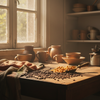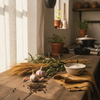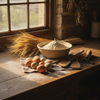Why Every Kitchen Needs a Glass Measuring Cup
The Glass Measuring Cup: Your Kitchen's Unsung Hero
Let's be honest—in the grand theater of kitchen tools, measuring cups rarely get the standing ovation. They're not the flashy copper pans or the knife sets that make your cooking friends swoon with envy. But here's the truth: that humble glass measuring cup might just be the most underrated superstar in your culinary arsenal.
At DI ORO, we believe great cooking starts with precision. And precision? That begins with proper measurement. Whether you're tackling your first soufflé or perfecting that holiday roast that's been intimidating you for years, accurate measurements can be the difference between "chef's kiss" and "let's order takeout."
I still remember my grandmother's ancient Pyrex glass measuring cup—the red markings faded but still legible, the weight of it substantial in my small hands as she taught me to bake. That measuring cup wasn't just a tool; it was the gateway to culinary confidence. And isn't that what we're all after in the kitchen? The ability to create with certainty?
What Makes Glass Measuring Cups Essential?

Glass measuring cups aren't just containers with lines—they're precision instruments designed for one purpose: to help you nail your recipes every single time. Unlike their plastic counterparts that can warp or their metal siblings that hide their contents, glass measuring cups offer transparency in every sense of the word.
Made from durable borosilicate or tempered glass, these kitchen workhorses stand up to hot liquids without warping, maintain their clarity over years of use, and offer measurement markings that won't fade after the first dozen dishwasher cycles. When America's Test Kitchen puts their stamp of approval on a kitchen tool, they're looking for exactly these qualities—reliability that stands the test of time, just like our award-winning silicone spatulas.
The Clear Advantage of Glass
Let's talk about why glass measuring cups deserve prime real estate in your kitchen cabinet:
- Heat Resistance: Pour boiling simple syrup or hot broth without worry—quality glass measuring cups can handle temperatures from freezing to boiling without cracking.
- Non-Reactive Surface: Unlike some plastics or metals, glass won't interact with acidic ingredients like tomatoes or lemon juice. What you measure stays exactly as intended.
- Visibility Factor: See exactly what you're measuring at eye level, with clear markings that eliminate guesswork.
- Microwave Friendly: Need to melt butter or warm milk? Do it right in your measuring cup—one less dish to clean!
- Longevity: With proper care, a quality glass measuring cup will outlast most relationships. (Too real? Maybe, but you know it's true.)
The Anatomy of a Perfect Glass Measuring Cup
Not all glass measuring cups are created equal. Like any kitchen tool worth its salt (measured precisely, of course), the details make all the difference. Here's what separates the good from the great:
The Glass Itself: Borosilicate vs. Tempered
The material matters tremendously. Borosilicate glass—the gold standard in many Pyrex glass measuring cup sets—contains boron trioxide, giving it remarkable resistance to thermal shock. This means you can pour hot liquid into a cool cup without shattering it. Tempered glass, while still durable, doesn't quite match borosilicate's thermal performance but offers excellent break resistance.
At DI ORO, we're sticklers for materials that perform without compromise—it's why we use pro-grade silicone free of forever chemicals in our spatulas. In measuring cups, the material directly impacts how confidently you can work with varying temperatures.
Measurement Markings: The Make-or-Break Feature
The true test of any glass measuring cup is its markings. The best ones feature:
- Bold, high-contrast colors (typically red) that remain visible even when measuring clear liquids
- Both imperial (cups, ounces) and metric (milliliters) measurements
- Markings that are either deeply etched or heat-fused to resist fading
- Clear spacing that prevents misreading between increments
When you're in the middle of reducing a sauce and need to add exactly 3/4 cup of stock, those clear markings become your culinary lifeline. No squinting, no guessing—just confidence.
Handle and Spout Design: Functionality Meets Comfort
The best glass measuring cups feature a handle that's comfortable to grip even when the cup contains hot liquid. The spout should pour cleanly without dribbling down the side (because who hasn't experienced the frustration of sticky maple syrup running down the outside of the cup and onto your countertop?)
A well-designed glass measuring cup with lid options adds versatility, allowing you to store leftover ingredients or shake dressings right in the measuring vessel. Talk about multitasking!
Popular Glass Measuring Cup Options

When we talk about glass measuring cups, certain brands have established themselves as kitchen standards. Whether you're browsing the glass measuring cup section at Walmart or looking for a specific Pyrex glass measuring cup set online, here's what you should know:
The Pyrex Legacy
Pyrex has been the household name in glass measuring cups for generations, and for good reason. Their classic design features:
- Clear glass with bold red measurements
- Durable construction that withstands years of use
- Available in 1-cup, 2-cup, 4-cup, and 8-cup sizes
- Sets that nest for efficient storage
The Pyrex 3-piece glass measuring cup set has become something of a standard wedding gift for a reason—it's the kitchen essential that never goes out of style. Like the little black dress of cookware, if you will.
Anchor Hocking: The Worthy Competitor
While Pyrex might get the lion's share of measuring cup fame, Anchor Hocking produces excellent glass measuring cups that deserve attention. Their measuring cups feature similar durability with slightly different handle ergonomics that some cooks prefer.
Both brands offer excellent options, and like choosing between high-quality kitchen spatulas, the "best" often comes down to personal preference and specific needs. At DI ORO, we understand that the perfect tool feels like an extension of your hand—intuitive and reliable.
Using Your Glass Measuring Cup Like a Pro
If you've ever watched a professional chef measure ingredients, you'll notice they don't just dump and go. There's a technique to using a glass measuring cup that elevates your cooking from "following a recipe" to "creating with precision." And isn't that what we're all after? That sweet spot where cooking becomes less about survival and more about artistry?
The Meniscus Matters: Reading Liquid Measurements Correctly
Here's a little science that makes a big difference: when measuring liquids, you'll notice the surface curves slightly at the edges, forming what's called a meniscus. The proper way to measure is to place your glass measuring cup on a flat surface, pour your liquid, then bend down so your eyes are level with the measurement line. Read the measurement at the bottom of the curve—not the top or the sides.
This eye-level reading technique is the difference between "close enough" cooking and "nailed it" precision. It's the same attention to detail we put into designing our award-winning spatulas that America's Test Kitchen recognized for their perfect balance of flexibility and strength.
Beyond Basic Measuring: Creative Uses
Your glass measuring cup isn't a one-trick pony. These versatile kitchen tools can multitask better than most of us on Monday morning:
- Mixing Station: Whisk salad dressings, marinades, or batters directly in the cup—the spout makes for easy pouring.
- Microwave Melting: Melt butter, chocolate, or warm milk without dirtying another dish.
- Portion Control: Use it to measure out perfect portions of soup, sauce, or morning smoothie.
- Quick Separator: Separate fat from stock or broth by pouring into the cup and letting it settle—the fat rises to the top for easy skimming.
- DIY Doubler: Need to double a recipe but don't trust your math? Measure ingredients into your cup twice instead of calculating.
A glass measuring cup with lid extends these possibilities even further, allowing you to shake, store, and transport ingredients with confidence. It's the kind of thoughtful design that makes cooking less chaotic and more joyful—exactly what we strive for with every DI ORO product.
The Glass Measuring Cup Showdown: Comparing Materials
While we're singing the praises of glass measuring cups, let's acknowledge the full lineup of measuring options and why glass often takes the crown:
Glass vs. Plastic Measuring Cups
Plastic measuring cups certainly have their place—they're lightweight and virtually unbreakable. But they come with significant drawbacks:
- They can absorb odors and stains from strong ingredients like turmeric or tomato
- Many plastics can't handle hot liquids without warping
- The measurement markings often fade after repeated dishwasher cycles
- Some may contain BPA or other chemicals you might prefer to keep away from your food
Glass, meanwhile, remains nonporous and resistant to staining, odors, and temperature changes. Like our forever-chemical-free silicone spatulas, glass measuring cups put health and safety first without compromising performance.
Glass vs. Metal Measuring Cups
Metal measuring cups excel for dry ingredients but fall short for liquids because:
- You can't see through them to verify your measurement
- They're not ideal for microwave use
- Some may react with acidic ingredients
- They conduct heat quickly, making them less comfortable to handle with hot liquids
Glass measuring cups provide visibility and versatility that metal simply can't match. They're the kitchen equivalent of having both style AND substance.
Caring for Your Glass Measuring Cup
A quality glass measuring cup can last decades—I've seen vintage Pyrex cups from the 1950s still going strong—but proper care makes all the difference. Here's how to ensure your measuring cup remains a kitchen heirloom:
Cleaning and Maintenance
While most glass measuring cups are dishwasher safe, hand washing occasionally can help preserve the measurement markings over time. For stubborn residue (looking at you, caramel sauce), soak in warm, soapy water before washing.
Avoid abrasive scrubbers that might scratch the glass or damage the markings. Instead, opt for gentle cleaning tools—the same care you'd take with your favorite non-stick pans and the silicone spatulas you use to protect them.
Storage Solutions
Nested storage works beautifully for glass measuring cup sets, saving valuable cabinet space. If stacking, place a paper towel or soft cloth between cups to prevent scratching or chipping.
For those blessed with ample kitchen space, hanging measuring cups by their handles on hooks provides easy access and visibility—a little kitchen organization that makes cooking more efficient. And isn't that what great tools are all about? Making the process as delightful as the outcome?
Choosing the Perfect Glass Measuring Cup for Your Kitchen

Ready to invest in this kitchen essential? Here's what to consider before making your purchase:
Size Matters: Which Capacity Do You Need?
Glass measuring cups typically come in several sizes, each with its own sweet spot of usefulness:
- 1-cup (8 oz): Perfect for small liquid amounts like vanilla extract, milk for coffee, or single-serving recipes.
- 2-cup (16 oz): The versatile workhorse for most everyday cooking needs—from measuring chicken broth to pancake batter.
- 4-cup (32 oz): Ideal for larger recipes, soups, and batch cooking projects.
- 8-cup (64 oz): The big kahuna for serious bakers and those who regularly cook for crowds.
For most home cooks, a set containing 1-cup, 2-cup, and 4-cup measuring cups covers virtually every kitchen scenario. It's like having our complete spatula set—you'll always have the right tool for the job, whether you're folding delicate egg whites or flipping a hefty steak.
Features Worth the Investment
Not all glass measuring cups are created equal. Premium features to look for include:
- Borosilicate glass for superior temperature resistance
- Ergonomic handles that provide a secure grip even with oven mitts
- Measurement markings on both sides for right or left-handed use
- Lids that seal tightly for storage
- Pour spouts designed to minimize drips
While you might pay a few dollars more for these features, the difference in performance and longevity makes it a worthwhile investment. Just as our customers find with DI ORO spatulas, paying a bit more upfront for quality tools saves money (and frustration) in the long run.
Where to Find Quality Glass Measuring Cups
Whether you're searching for a specific glass measuring cup at Walmart, exploring options for a glass measuring cup with lid, or comparing different Pyrex glass measuring cup sets, you have plenty of shopping options:
- Kitchen specialty stores offer hands-on shopping experience and knowledgeable staff
- Department stores typically stock reliable basics at competitive prices
- Online retailers provide the widest selection and customer reviews
- Brand websites often feature complete product lines and exclusive sets
Wherever you shop, look for retailers that stand behind their products with solid return policies and guarantees—the same customer-first approach we take with our lifetime warranty on DI ORO kitchen tools.
Taking Your Measuring Game to the Next Level
Let's be honest—measuring cups aren't usually the kitchen tools that make your heart race with excitement. But like that reliable friend who's always there when you need them, a quality glass measuring cup becomes the unsung hero of countless culinary victories. It's the difference between a sauce that's "just right" and one that's "almost there." And for those of us who love creating memorable meals, "almost" simply isn't good enough.
Perfect Pairings: Complementary Kitchen Tools
Your glass measuring cup works best when partnered with other precision tools. Think of it as assembling your culinary dream team:
- Silicone Spatulas: For scraping every last drop from your glass measuring cup, nothing beats a flexible, heat-resistant spatula. DI ORO's award-winning Seamless Series spatulas, recognized by America's Test Kitchen for their exceptional performance, ensure you're getting every bit of that precisely measured ingredient into your recipe. Explore our Seamless Series Spatulas.
- Digital Kitchen Scale: For ultimate precision, weigh ingredients directly in your glass measuring cup (just remember to tare the scale first).
- Measuring Spoons: When recipes call for smaller amounts, a good set of measuring spoons complements your glass measuring cup perfectly. For tips on choosing the safest, most reliable sets, check out this guide to non-toxic measuring spoons and cups.
- Dry Measuring Cups: Remember that liquids and dry ingredients require different measuring tools for accuracy—the right tool for the right job always yields better results.
This culinary toolkit approach is something we embrace at DI ORO, where our kitchen tools are designed to work together seamlessly, just like the ingredients in your favorite recipe.
Common Questions About Glass Measuring Cups
Even the most straightforward kitchen tools come with questions. Let's address some frequently asked concerns about glass measuring cups:
Can I Put My Glass Measuring Cup in the Oven?
Most glass measuring cups are oven-safe, but with important caveats. Pyrex glass measuring cups, for instance, can typically handle temperatures up to 425°F. However, always check the manufacturer's guidelines first. Avoid subjecting glass to sudden temperature changes—no transferring directly from freezer to oven or placing a hot measuring cup on a cold, wet surface. This thermal shock can cause even the best glass to crack.
This approach to temperature management mirrors how we designed our silicone spatulas to withstand heat up to 600°F—giving you confidence to cook boldly without worrying about your tools failing when you need them most.
Are Glass Measuring Cups Microwave Safe?
Yes! This is one of their greatest advantages. Quality glass measuring cups like those from Pyrex or Anchor Hocking are perfectly microwave safe, making them ideal for melting butter, warming milk, or heating water for recipes. The convenient handle stays cooler than the glass, allowing safer removal from the microwave.
Just remember to use the microwave's power levels appropriately—full power isn't always necessary and can sometimes lead to boil-overs or uneven heating.
What's the Difference Between Liquid and Dry Measuring Cups?
This common confusion deserves clarification: Liquid measuring cups (like our glass heroes) are designed with room above the highest measurement line, allowing you to pour and measure without spillage. They're meant to be filled to the line and read at eye level. For a deeper dive on the differences and how to choose, read this practical article: Liquid Measuring Cups: What You Must Know.
Dry measuring cups, meanwhile, are designed to be filled to the brim and leveled off with a straight edge. Using the wrong type can significantly impact your recipe's outcome—especially in baking where precision matters most.
It's like using a spoonula when you really need a turner—both are spatulas, but they're engineered for different purposes. The right tool makes all the difference in the final result.
The Ultimate Glass Measuring Cup Buying Guide
Budget-Friendly Options That Don't Sacrifice Quality
While premium glass measuring cups offer superior features, you don't need to break the bank for a reliable option. Many glass measuring cup sets at Walmart or other major retailers provide excellent value around the $15-25 range. Look for tempered glass construction and clear, easy-to-read markings as minimum requirements.
Remember that even budget-friendly glass measuring cups will likely outlast several plastic alternatives—making them the more economical choice in the long run. It's the same value philosophy we embrace at DI ORO: invest once in quality tools that perform exceptionally and last for years.
Premium Features Worth the Splurge
For those willing to invest a bit more, these premium features elevate the humble measuring cup to something truly special:
- Snap-on Lids: A glass measuring cup with lid lets you mix, measure, and store in one container—perfect for make-ahead pancake batter or salad dressing.
- Non-Slip Bases: Some high-end models feature silicone bottoms that grip countertops, preventing slides and spills during vigorous mixing.
- Multiple Spouts: Ambidextrous designs with pour spouts on both sides cater to both left and right-handed cooks.
- Measurement Scales: Advanced models include multiple measurement systems (cups, ounces, milliliters) for international recipe compatibility.
These thoughtful design elements reflect the same attention to detail we put into every DI ORO kitchen tool—where form and function unite to create something that's not just useful, but a joy to use.
Conclusion: Why Every Kitchen Deserves a Quality Glass Measuring Cup
In a world of flashy kitchen gadgets that promise the moon but deliver disappointment, the humble glass measuring cup stands as a testament to enduring design and practical utility. It's the quiet achiever that transforms guesswork into consistency, approximation into precision.
Whether you're a seasoned chef or someone just discovering the joy of cooking, accurate measurement is the foundation of culinary success. A quality glass measuring cup—or better yet, a well-chosen set—provides that foundation with transparency (literally and figuratively), durability, and versatility that other materials simply can't match.
At DI ORO, we believe that cooking should be both joyful and successful—and that starts with having the right tools for the job. Just as our award-winning spatulas have earned recognition from America's Test Kitchen and Food Network for their exceptional performance and forever-chemical-free construction, a quality glass measuring cup earns its place in your kitchen through reliability, precision, and versatility.
So whether you're eyeing that Pyrex glass measuring cup set you've seen in professional kitchens, or considering a glass measuring cup with lid for added convenience, know that you're investing in a kitchen essential that will serve you faithfully through countless recipes and culinary adventures.
Because in the end, cooking isn't just about feeding ourselves—it's about creating something memorable. And with the right tools in hand, those memorable moments become a whole lot easier to achieve, one perfectly measured cup at a time.
Ready to keep learning? Check out these 4 things to know before buying measuring cups to further refine your kitchen toolkit.
Ready to continue building your collection of premium kitchen tools? Shop DI ORO's best sellers or browse all DI ORO kitchen tools that pair perfectly with your measuring essentials. Because when precision meets performance, culinary magic happens.
Frequently Asked Questions
What is the glass measuring cup called?
A glass measuring cup is commonly referred to simply as a 'measuring cup,' but when made from glass, it's sometimes called a 'glass liquid measuring cup.' These cups are designed specifically for measuring liquids and often feature a spout for easy pouring, as well as clear, easy-to-read measurement markings along the side.
What's up with the Pyrex measuring cup?
The Pyrex measuring cup is a well-known kitchen staple, famous for its durability and clear, easy-to-read markings. Pyrex has been producing these glass measuring cups for decades, and they’re prized for their resistance to thermal shock, making them handy for both hot and cold ingredients. Over the years, changes in manufacturing—especially the type of glass used—have sparked discussions about their strength and reliability, but they remain a favorite in many kitchens.
Is it safe to put a glass measuring cup in the microwave?
In general, most glass measuring cups, including those made by reputable brands like Pyrex, are safe to use in the microwave. However, it's important to check the manufacturer's guidelines before microwaving, especially if the cup has any metallic decorations or damage. Always avoid sudden temperature changes, as this can cause the glass to crack or shatter.
Are Pyrex glass measuring cups safe?
Yes, Pyrex glass measuring cups are generally safe for everyday kitchen use, including measuring, mixing, and heating. They are made from tempered glass that resists breaking under typical cooking conditions. However, to ensure safety, avoid exposing them to extreme temperature changes, such as moving from freezer to oven, as this can cause the glass to fail.
Can a Pyrex glass measuring cup go in the oven?
Many Pyrex glass measuring cups are oven-safe, but only up to certain temperatures—usually around 425°F (218°C). Always check your specific product's instructions before placing it in the oven, and avoid using it under a broiler or on stovetops. Never subject the glass to rapid temperature changes, as this increases the risk of breakage.
How can you tell if a Pyrex measuring cup is vintage?
You can often identify a vintage Pyrex measuring cup by examining the logo and markings on the glass. Older Pyrex items usually have all-capital block lettering and sometimes feature 'Made in USA' or specific patent numbers. Vintage cups may also have thicker glass and a more substantial feel compared to newer versions.



